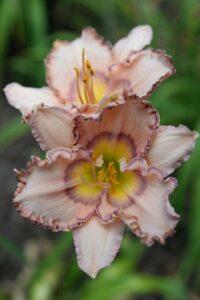 What better plant to feature on Release Day than daylilies? This is one of the most adaptable flowering plants in the world, and yet, I had never heard of them before moving to Tennessee. It was because of sweet friends we met the first time at our church that my yard is now adorned with these amazing flowers. Kenny and Jackie were given some by various friends, and they wanted to spread the wealth with us. The epitome of Southern hospitality.
What better plant to feature on Release Day than daylilies? This is one of the most adaptable flowering plants in the world, and yet, I had never heard of them before moving to Tennessee. It was because of sweet friends we met the first time at our church that my yard is now adorned with these amazing flowers. Kenny and Jackie were given some by various friends, and they wanted to spread the wealth with us. The epitome of Southern hospitality.
Surrounding their home on several acres, are a wide variety of daylilies. “You want some?” Kenny had asked. Before I even answered with a resounding “Yes!” he grabbed a spade and led Chris and me through his yard. Every color imaginable, some with ruffled edges, some with smooth. A few of this color, a few of that, and I had a truckload of daylily tubers for my own yard.
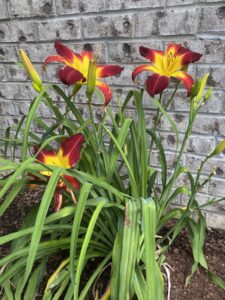 You won’t find a more versatile (and stunning) plant. They will grow in zones 2 through 11, are cold-hardy and heat-tolerant. Because they’re low maintenance, they work in some of the toughest spots in the garden as an ornamental plant, ground cover, and weed control. They’ll grow in most any soil condition and climate. I stuck them in places that didn’t receive anything more nutritious than sunlight, and they took off.
You won’t find a more versatile (and stunning) plant. They will grow in zones 2 through 11, are cold-hardy and heat-tolerant. Because they’re low maintenance, they work in some of the toughest spots in the garden as an ornamental plant, ground cover, and weed control. They’ll grow in most any soil condition and climate. I stuck them in places that didn’t receive anything more nutritious than sunlight, and they took off.
When reading about daylilies, I was pleasantly surprised at one gardener’s suggestion of using them in pots. You may have heard that potted plants should provide three different forms—spiller, filler, and thriller. You can get all three in one daylily. Their long, grass-like leaves will cascade over the sides of the containers (spiller), their dense growth will provide the filler, and the blooms growing on tall wand-like flowers will add height (thriller). Talk about resourceful!
So, where did daylilies come from? They’re native to the entire Asian continent—and they even have an Asian flair to them, don’t you think? By the 18th century, they had made it to Europe, where they became very popular. European immigrants brought daylily tubers with them to North America, and the flowers had naturalized here by the early 1800s.
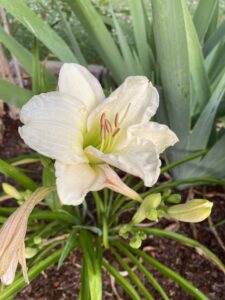 You may be thinking that daylilies are lilies. Ironically, they aren’t. I could share all the fancy Latin names and how they aren’t in the lily family (Lilium) but in the Hemerocallis family, but it made my head hurt just reading about it. True lilies are very toxic to humans and animals. Where hermerocallis fulva (the orange daylily) has been known to be edible for generations. Of the 80,000 varieties, this one is the most widespread. They can be found growing just about anywhere, including old homesteads, roadsides, and alleyways.
You may be thinking that daylilies are lilies. Ironically, they aren’t. I could share all the fancy Latin names and how they aren’t in the lily family (Lilium) but in the Hemerocallis family, but it made my head hurt just reading about it. True lilies are very toxic to humans and animals. Where hermerocallis fulva (the orange daylily) has been known to be edible for generations. Of the 80,000 varieties, this one is the most widespread. They can be found growing just about anywhere, including old homesteads, roadsides, and alleyways.
Now to explain where the daylily gets its name (just in case you don’t know). Their flowers typically bloom for only one day before being replaced by a new one. Most varieties have a flush of flowers in the summer and only bloom for about a month. But horticulturists are always looking to make new and improved varieties, so now there are many that will rebloom. They start in late spring or early summer, stop blooming, and then rebloom again in late summer or early fall. I don’t happen to have any of these varieties, because every daylily in my yard was gifted to me by my friends. And now I can regift them to others, which is one of the joys of gardening.
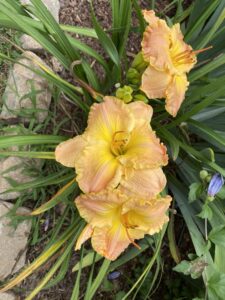
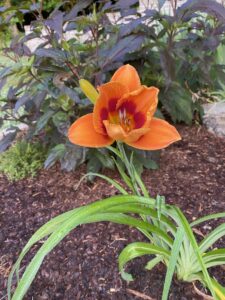 Chris and I are building a new house, which means I’m going to need to start from scratch with new landscaping. I’d asked Kenny if he thought I could dig up some of my tubers (a type of rhizome), store them through the winter, and replant in the new yard in spring. “Yes,” he said. “But why do that when you can come back to our house, and we’ll dig you up as many as you need?”
Chris and I are building a new house, which means I’m going to need to start from scratch with new landscaping. I’d asked Kenny if he thought I could dig up some of my tubers (a type of rhizome), store them through the winter, and replant in the new yard in spring. “Yes,” he said. “But why do that when you can come back to our house, and we’ll dig you up as many as you need?”
See what I mean about Southern hospitality? It’s alive and well here in Tennessee.
You may not be able to purchase these beauties on Amazon, but be sure to enter here for a chance to win a $25 Gift Card anyway. Maybe you can use them for gardening tools, or seeds, or a book!






